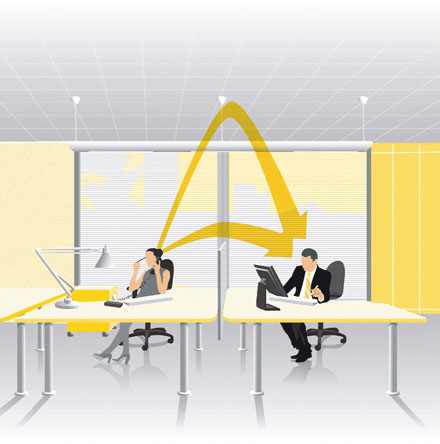Spatial decay
The sound level decreases as the distance to the sound source increases. The design of the room (shape, furnishing, surface finish etc.) influences the extent to which the sound level decreases along with the distance.
Speech at 1 m distance
Speech at 4 m distance
Speech at 8 m distance
To characterise the propagation of the sound there is a parameter that describes the extent to which the sound decreases when the distance is doubled. This parameter, designated DL2 and measured in dB, determines the slope of the sound propagation curve. Another parameter, DLf, also measured in dB, shows how the sound level at a certain distance is related to the sound level at the same distance in a free soundfield, i.e. without reflecting objects. A high DL2 and a low DLf ensure limited disturbance between work places.
DL2
DLf

AC is a classification of suspended ceilings according to there ability to contribute to the acoustic privacy between work stations. This method provides measurements of the sound reflective characteristics of ceilings used together with screens.
|
Perceived attribute |
Objective descriptor |
Designation |
Unit |
Explanation |
Standard |
|
Spatial decay |
Rate of spatial decay of sound pressure per distance doubling. |
DL2 |
dB |
Measures how much the sound decreases with distance from sound source. |
ISO 14257 |
|
Spatial decay |
Excess of sound pressure level with respect to a reference sound distribution curve. | DLf | dB | Measure of room’s contribution to the sound or noise level at different distances from sound source. | ISO 14257 |
|
Spatial decay |
Articulation Class |
AC |
Index |
Classification of ceilings in accordance with their ability to contribute to privacy in open-plan offices. |
ASTM E 1110 (2001) |
